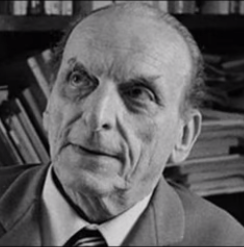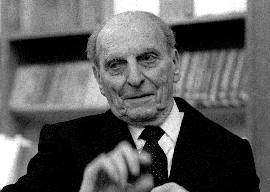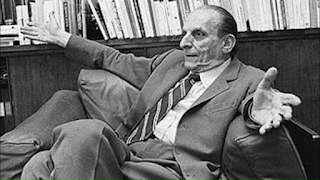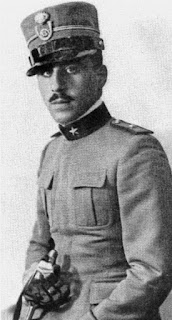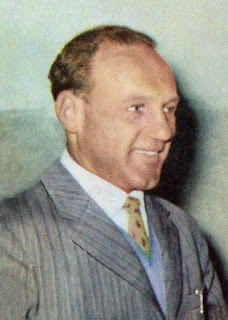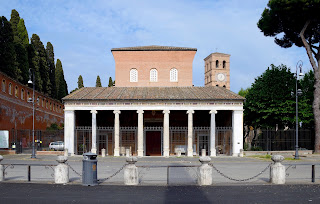Claimed to be the man who killed Mussolini
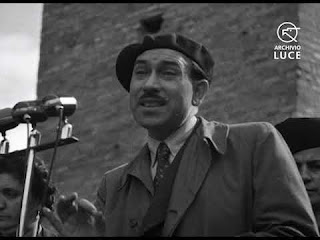 |
| Walter Audisio addressing a Communist Party rally a couple of years after the end of the Second World War |
Mussolini was captured in the town of Dongo on the shore of Lake Como as he tried to flee from Italy to Switzerland, having accepted that the Axis powers were facing near-certain defeat to the Allies as the Second World War moved into its final phase.
He was taken along with his entourage to the village of Giulino di Mezzegra, 20km (12 miles) south of Dongo along the lakeside road, and after spending the night under guard in a remote farmhouse was taken back into the village, where he and his mistress, Claretta Petacci, were ordered to stand against a wall.
There they were shot dead by a partisan who went under the nom de guerre of "Colonnello Valerio", before their bodies were taken to Milan and hung by their feet from the roof of a petrol station in Piazzale Loreto, which had been the scene of the massacre of 15 partisans a year earlier.
 |
| A simple cross marks the place where Mussolini and his mistress, Claretta Petacci, were killed in a lakeside village |
Audisio claimed that, as an official of the National Liberation Committee (CLN) and the head of the Italian resistance in Milan, he had been ordered to carry out the sentence in accordance with a CLN directive that all Fascist leaders were liable to the death penalty.
His account of the execution described how the dictator and his mistress cowered before him as they awaited their fate, their agony prolonged as his own machine gun and then his pistol each jammed as he pulled the trigger. Another partisan, standing nearby, handed him a second machine gun, which did successfully discharge.
Audisio claimed that he felt he was shooting “not a man but an inferior being” and said that Mussolini had shown no dignity. He said that his mistress, who he also killed, had pleaded for her lover to be spared.
 |
| Audisio served as a Deputy from 1948 to 1963 |
Upon his release, he resumed his activities against the government of Benito Mussolini, and in September 1943 he started to organize the first bands of partisans in Casale Monferrato, not far from Alessandria. During this time he managed to hold down a job in the Fascist civil service.
He joined the Italian Communist Party and became the inspector of the Garibaldi Brigades, a faction of the National Liberation Committee, commanding formations operating in the Province of Mantova and the Po Valley.
By January 1945, he had become the principal figure of the Italian resistance movement in Milan, where he acquired his nom de guerre. Confusingly, the name Colonnello Valerio may also have been used by Luigi Longo, another partisan.
Once the conflict was over, Audisio continued to work with the communist movement, and in 1948 was elected to the Chamber of Deputies for Alessandria as an Italian Communist Party member and part of the Popular Democratic Front. From 1948 to 1963, he served three consecutive terms as a Deputy. As a legislator, he was a consistent supporter of bills to outlaw or curb fascism.
 |
| Audisio's tomb at the Cimitero Comunale Monumentale Campo Verano in Rome |
Audisio died five years later in 1973 of a heart attack. He was buried at the Cimitero Comunale Monumentale Campo Verano in Rome.
His memoirs, titled In nome del popolo italiano - In the Name of the Italian People - were published two years after his death, in 1975.
 |
| Dongo is a picturesque town on the shore of Lake Como |
Dongo is one of many picturesque towns along the shore of Lake Como, with a number of hotels, restaurants and shops. It is very popular during the summer months and also attracts walkers, who can explore nearby mountain villages on foot. Dongo has a small harbour adjoining the town's main square, where one can find the Palazzo Manzi, built in 1803 and now Dongo's town hall. The ground floor houses the Museum of the End of the War, refurbished in 2014, dedicated to the partisans and in particular to the capture of Mussolini.
 |
| The city of Alessandria, with the famous Cittadella in the foregroud |
The historic city of Alessandria became part of French territory after the army of Napoleon defeated the Austrians at the Battle of Marengo in 1800. It was ruled by the Kingdom of Sardinia for many years and is notable for the Cittadella di Alessandria, a star-shaped fort and citadel built in the 18th century, which today it is one of the best preserved fortifications of that era, even down to the surrounding environment. Situated across the Tanaro river to the north-west of the city, it has no buildings blocking the views of the ramparts, or a road bordering the ditches.
More reading:
The founding of the Italian Fascists
Mussolini's last stand
The death of Benito Mussolini
Also on this day:
1503: The birth of Giovanni della Casa, advocate of good manners
1952: The birth of Olympic sprint champion Pietro Mennea
1971: The birth of footballer Lorenzo Amoruso
Home
